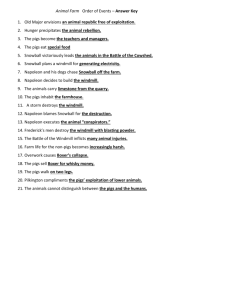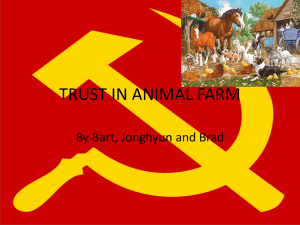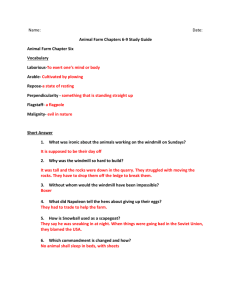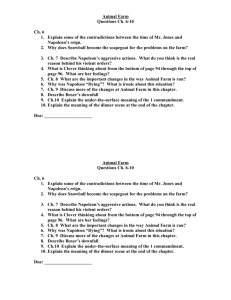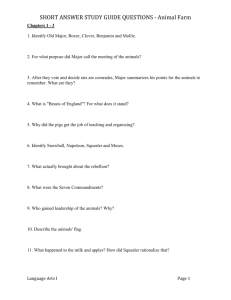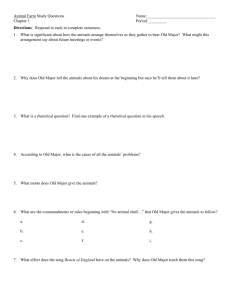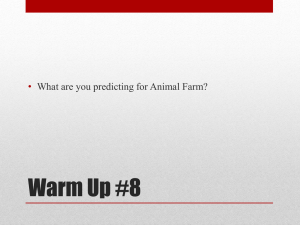Animal Farm
advertisement
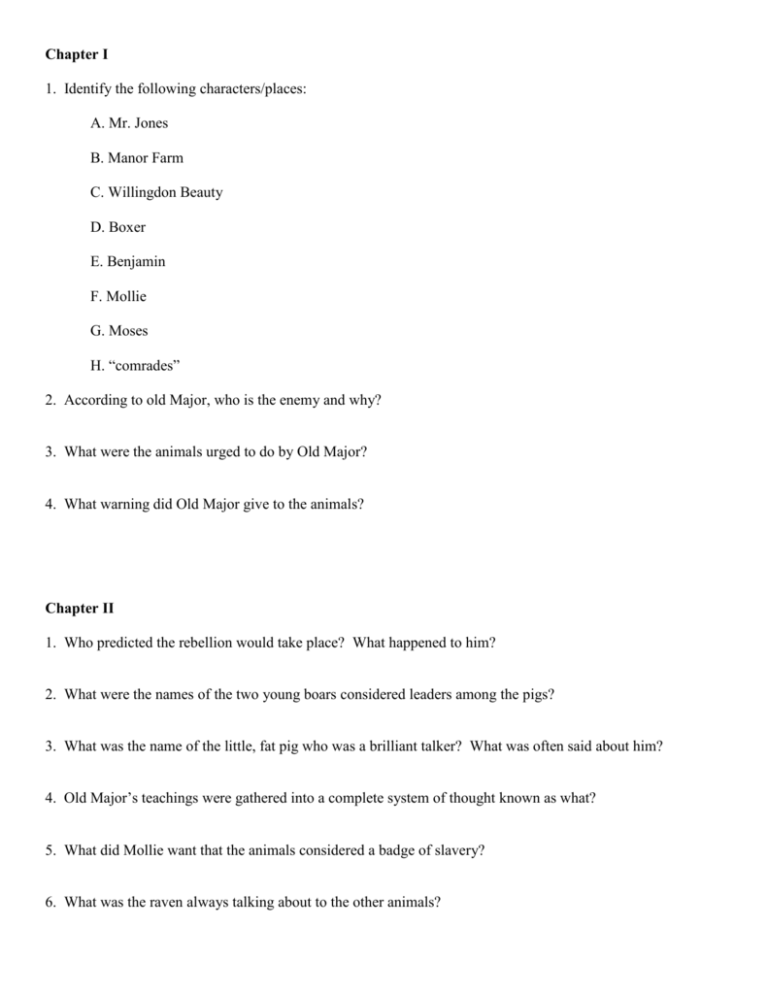
Chapter I 1. Identify the following characters/places: A. Mr. Jones B. Manor Farm C. Willingdon Beauty D. Boxer E. Benjamin F. Mollie G. Moses H. “comrades” 2. According to old Major, who is the enemy and why? 3. What were the animals urged to do by Old Major? 4. What warning did Old Major give to the animals? Chapter II 1. Who predicted the rebellion would take place? What happened to him? 2. What were the names of the two young boars considered leaders among the pigs? 3. What was the name of the little, fat pig who was a brilliant talker? What was often said about him? 4. Old Major’s teachings were gathered into a complete system of thought known as what? 5. What did Mollie want that the animals considered a badge of slavery? 6. What was the raven always talking about to the other animals? 7. What element of society might Moses and his message symbolize? 8. Why did the animals break into the storehouse? 9. After removing Jones and his men from Manor Farm, what did the animals destroy? 10. In a fable, characters are often animals that think and act like humans. What human behavior do the animals indulge in to celebrate expelling Jones? 11. What human trait is exhibited when they bury the hams found in the farmhouse? 12. What did the animals decide to preserve the farmhouse as? 13. During the first three months following the rebellion, what do the pigs teach themselves to do? 14. List the seven commandments as they were written on the barn. A. B. C. D. E. F. G. 15. How does Orwell foreshadow the pigs’ decision not to share the milk with the rest of the animals? Chapter III 1. What made the harvest work so difficult? What made it easy? 2. What was Boxer’s motto? 3. Which two animals seemed the most reluctant to work? 4. Which animal seemed the most unchanged by the rebellion? 5. What did the animals do on Sundays? 6. What was the harness room used for? What did the pigs do there? 7. What were the names of Snowball’s committees? 8. Who was very successful in reading? Who was the most unsuccessful? 9. So that the sheep would be able to remember, the Seven Commandments were reduced to what single maxim? 10. What animals did Napoleon take away as babies to educate? 11. What reason does Napoleon give for taking away Jessie and Bluebell’s puppies? 12. According to Squealer’s propaganda, why were the milk and apples being taken? Chapter IV 1. What were the names of the neighboring farms and their farmers? 2. What causes Mr. Jones, along with men from Pilkington’s and Frederick’s farms, to try to conquer Animal Farm? 3. Who was in charge of the defense of the farm? 4. How long did this first “battle” last? 5. What were the “casualties,” both human and animal? Who was presumed dead, but later awoke? 6. What was the battle named? 7. What happened to Jones’s gun? 8. How do Snowball and Boxer earn the award, “Animal Hero, First Class”? Chapter V 1. What is found out about Mollie in the beginning of chapter V? 2. Where is Mollie seen after she leaves the farm, and how does she appear? 3. How did Snowball gain support for his ideas? How did Napoleon? 4. What did Snowball decide to build and what would it be used for? 5. What is Benjamin’s opinion of the windmill situation? 6. What happens to Snowball immediately after he convinces everyone that the windmill should be built? 7. What role do the dogs play in Snowball’s expulsion? 8. What was Napoleon’s motivation in having Snowball expelled? 9. What changes does Napoleon make immediately after the expulsion of Snowball? 10. What maxim does Boxer create when the Sunday debates are canceled? Chapter VI 1. Discuss the problems with the windmill. 2. What items do the animals find they are missing? What new policy does Napoleon introduce in order to get these items? 3. Why do you think that all of the animals do not rebel against the unjust treatment they receive from their leaders? 4. What major changed occurred with the pigs’ living conditions? 5. What is the first commandment change? 6. How does Squealer explain this change? 7. What happened at the end of the chapter that dashed the animals’ hopes for success? 8. Who is the scapegoat every time something goes wrong? Chapter VII 1. Why did the chickens rebel against the pigs? What happened to their rebellion? 2. What deal was Napoleon trying to settle between the neighboring farms? What was supposedly delaying his decision? What do you think was actually delaying his decision? 3. Re-read the trial and “execution of the traitors.” What was Napoleon’s motivation for this purge? How does this event create an analogy to particular events in history? 4. What happened to the song “Beasts of England? What is the reason given for this change? What is Napoleon’s actual motivation for his actions? Chapters VIII 1. What was the second commandment change? 2. What were some of the changes in Napoleon’s behavior? 3. What rumors were being heard about Frederick? 4. Who finally purchased the timber from Animal Farm? How does Frederick trick Napoleon? 5. When Frederick and his men attack the farm, who does Napoleon turn to for help? What is his response? 6. What do the men succeed in doing? What do the animals do in return? 7. What were the casualties of the battle? What was the battle named? 8. What announcement was made the morning after the battle? What turned out to be the truth? 9. What was the third commandment change? Who realized what the pigs were doing? Chapter IX 1. How is the theme “power corrupts” evident in the privileges gained by the pigs? 2. What is ironic about the fact that Napoleon introduces Spontaneous Demonstrations and orders that they be held every week? 3. Since the pigs do not believe Moses’ stories of Sugarcandy Mountain, why do they allow his presence on the farm rather than expel him? 4. Who worked the hardest on the windmill? After Boxer is unable to work, what happens to him? 5. List three reasons for Boxer’s elimination? 6. What aspects of the “memorial banquet” for Boxer are ironic? Chapter X 1. What is the windmill used for once it is finally completed? 2. What are six final changes in the pigs that occur in chapter 10? A. B. C. D. E. F. 3. What became the final commandment change? Why does the word “more” cancel out the meaning of the new Commandment that appears on the barn wall in Chapter 10? 5. At the end of the story, the animals see the pigs and the men together in the farmhouse. What do they notice about them? What is the symbolic meaning?
